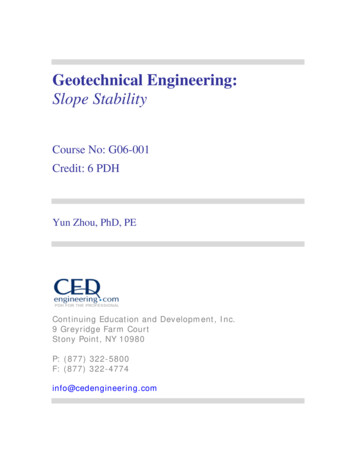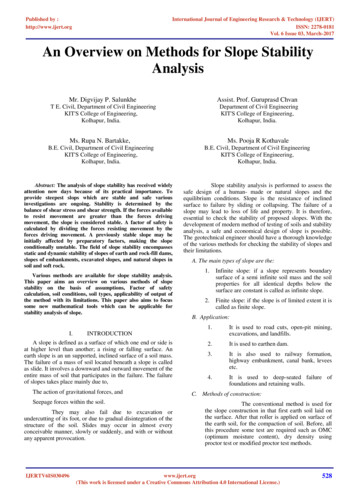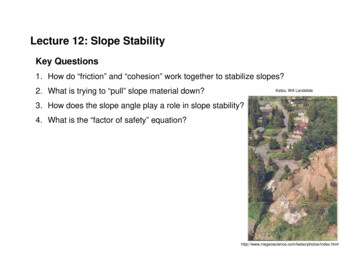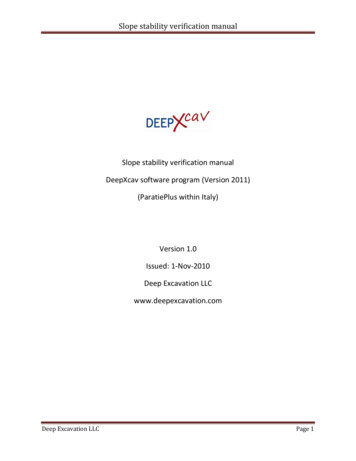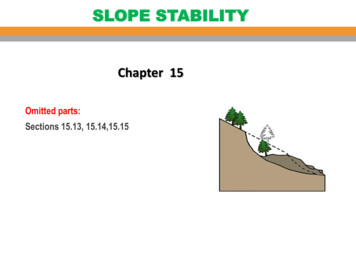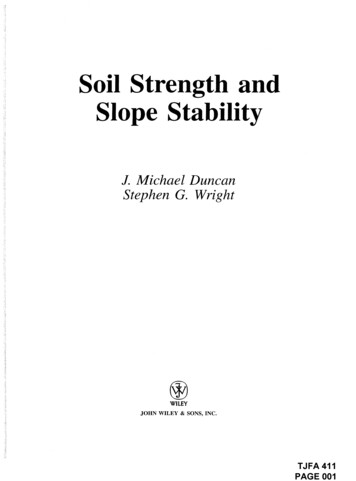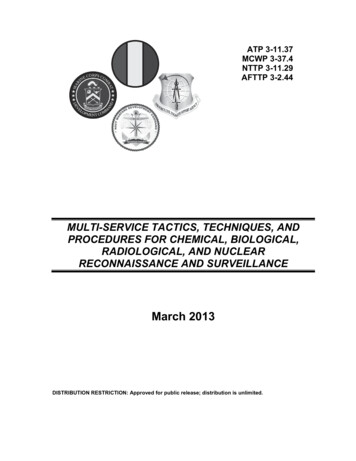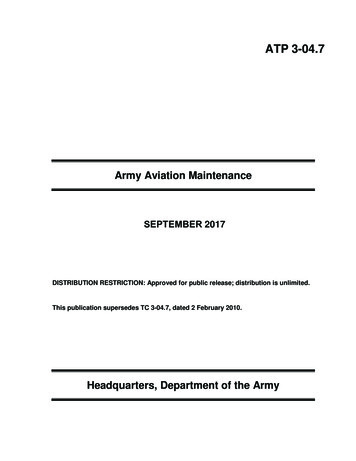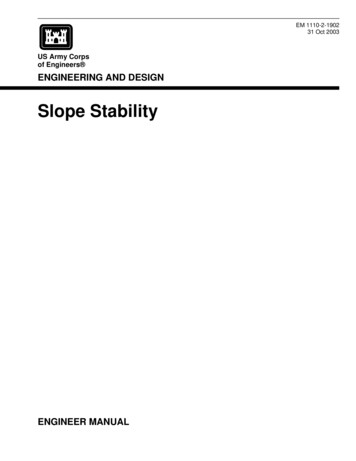
Transcription
EM 1110-2-190231 Oct 2003US Army Corpsof Engineers ENGINEERING AND DESIGNSlope StabilityENGINEER MANUAL
AVAILABILITYElectronic copies of this and other U.S. Army Corps ofEngineers (USACE) publications are available on the Internet athttp://www.usace.army.mil/inet/usace-docs/. This site is theonly repository for all official USACE engineer regulations,circulars, manuals, and other documents originating fromHQUSACE. Publications are provided in portable documentformat (PDF).
CECW-EWDEPARTMENT OF THE ARMYU.S. Army Corps of EngineersWashington, DC 20314-1000ManualNo. 1110-2-1902EM 1110-2-190231 October 2003Engineering and DesignSLOPE STABILITY1. Purpose. This engineer manual (EM) provides guidance for analyzing the static stability of slopesof earth and rock-fill dams, slopes of other types of embankments, excavated slopes, and natural slopes insoil and soft rock. Methods for analysis of slope stability are described and are illustrated by examples inthe appendixes. Criteria are presented for strength tests, analysis conditions, and factors of safety. Thecriteria in this EM are to be used with methods of stability analysis that satisfy all conditions ofequilibrium. Methods that do not satisfy all conditions of equilibrium may involve significantinaccuracies and should be used only under the restricted conditions described herein.2. Applicability. This EM is applicable to all USACE elements and field operating activities havingresponsibility for analyzing stability of slopes.3. Distribution Statement. This publication is approved for public release; distribution is unlimited.4. Scope of the Manual. This manual is intended to guide design and construction engineer, ratherthan to specify rigid procedures to be followed in connection with a particular project.FOR THE COMMANDER:7 Appendixes(See Table of Contents)MICHAEL J. WALSHColonel, Corps of EngineersChief of StaffThis manual supersedes EM 1110-2-1902, 1 April 1970.
CECW-EWDEPARTMENT OF THE ARMYU.S. Army Corps of EngineersWashington, DC 20314-1000ManualNo. 1110-2-1902EM 1110-2-190231 October 2003Engineering and DesignSLOPE STABILITYSubjectParagraphPageChapter 1IntroductionPurpose and Scope .1-1Applicability .1-2References.1-3Notation and Glossary.1-4Basic Design Considerations .1-5Stability Analysis and Design Procedure.1-6Unsatisfactory Slope Performance.1-71-11-11-11-11-11-41-5Chapter 2Design ConsiderationsIntroduction.2-1Aspects Applicable to all Load Conditions.2-2Analyses of Stability during Construction and at the End of Construction .2-3Analyses of Steady-State Seepage Conditions.2-4Analyses of Sudden Drawdown Stability .2-5Analyses of Stability during Earthquakes .2-62-12-22-92-102-112-12Chapter 3Design CriteriaGeneral.3-1New Embankment Dams .3-2Existing Embankment Dams.3-3Other Slopes.3-43-13-33-33-4Chapter 4Calculations and PresentationsAnalysis Methods.4-1Verification of Computer Analyses and Results.4-2Presentation of the Analysis and Results .4-34-14-14-7Appendix AReferencesAppendix BNotationi
EM 1110-2-190231 Oct 03SubjectAppendix CStability Analysis Procedures – Theory and LimitationsAppendix DShear Strength CharacterizationAppendix EChart Solutions for Embankment SlopesAppendix FExample Problems and CalculationsAppendix GProcedures and Examples for Rapid DrawdowniiParagraphPage
EM 1110-2-190231 Oct 03Chapter 1Introduction1-1. Purpose and ScopeThis engineer manual (EM) provides guidance for analyzing the static stability of slopes of earth and rock-filldams, slopes of other types of embankments, excavated slopes, and natural slopes in soil and soft rock.Methods for analysis of slope stability are described and are illustrated by examples in the appendixes.Criteria are presented for strength tests, analysis conditions, and factors of safety. The criteria in this EM areto be used with methods of stability analysis that satisfy all conditions of equilibrium. Methods that do notsatisfy all conditions of equilibrium may involve significant inaccuracies and should be used only under therestricted conditions described herein. This manual is intended to guide design and construction engineers,rather than to specify rigid procedures to be followed in connection with a particular project.1-2. ApplicabilityThis EM is applicable to all USACE elements and field operating activities having responsibility foranalyzing stability of slopes.1-3. ReferencesAppendix A contains a list of Government and non-Government references pertaining to this manual. Eachreference is identified in the text by either the designated publication number or by author and date.1-4. Notation and GlossarySymbols used in this manual are listed and defined in Appendix B. The notation in this manual correspondswhenever possible to that recommended by the American Society of Civil Engineers.1-5. Basic Design Considerationsa. General overview. Successful design requires consistency in the design process. What areconsidered to be appropriate values of factor of safety are inseparable from the procedures used to measureshear strengths and analyze stability. Where procedures for sampling, testing, or analysis are different fromthe procedures described in this manual, it is imperative to evaluate the effects of those differences.b. Site characterization. The stability of dams and slopes must be evaluated utilizing pertinent geologicinformation and information regarding in situ engineering properties of soil and rock materials. The geologicinformation and site characteristics that should be considered include:(1) Groundwater and seepage conditions.(2) Lithology, stratigraphy, and geologic details disclosed by borings and geologic interpretations.(3) Maximum past overburden at the site as deduced from geological evidence.(4) Structure, including bedding, folding, and faulting.(5) Alteration of materials by faulting.1-1
EM 1110-2-190231 Oct 03(6) Joints and joint systems.(7) Weathering.(8) Cementation.(9) Slickensides.(10) Field evidence relating to slides, earthquake activity, movement along existing faults, and tensionjointing.c. Material characterization. In evaluating engineering properties of soil and rock materials for use indesign, consideration must be given to: (1) possible variation in natural deposits or borrow materials,(2) natural water contents of the materials, (3) climatic conditions, (4) possible variations in rate and methodsof fill placement, and (5) variations in placement water contents and compacted densities that must beexpected with normal control of fill construction. Other factors that must be considered in selecting values ofdesign parameters, which can be evaluated only through exercise of engineering judgment, include: (1) theeffect of differential settlements where embankments are located on compressible foundations or in narrow,deep valleys, and (2) stress-strain compatibility of zones of different materials within an embankment, or ofthe embankment and its foundation. The stability analyses presented in this manual assume that designstrengths can be mobilized simultaneously in all materials along assumed sliding surfaces.d. Conventional analysis procedures (limit equilibrium). The conventional limit equilibrium methods ofslope stability analysis used in geotechnical practice investigate the equilibrium of a soil mass tending tomove downslope under the influence of gravity. A comparison is made between forces, moments, or stressestending to cause instability of the mass, and those that resist instability. Two-dimensional (2-D) sections areanalyzed and plane strain conditions are assumed. These methods assume that the shear strengths of thematerials along the potential failure surface are governed by linear (Mohr-Coulomb) or nonlinearrelationships between shear strength and the normal stress on the failure surface.(1) A free body of the soil mass bounded below by an assumed or known surface of sliding (potential slipsurface), and above by the surface of the slope, is considered in these analyses. The requirements for staticequilibrium of the soil mass are used to compute a factor of safety with respect to shear strength. The factorof safety is defined as the ratio of the available shear resistance (the capacity) to that required for equilibrium(the demand). Limit equilibrium analyses assume the factor of safety is the same along the entire slip surface.A value of factor of safety greater than 1.0 indicates that capacity exceeds demand and that the slope will bestable with respect to sliding along the assumed particular slip surface analyzed. A value of factor of safetyless than 1.0 indicates that the slope will be unstable.(2) The most common methods for limit equilibrium analyses are methods of slices. In these methods,the soil mass above the assumed slip surface is divided into vertical slices for purposes of convenience inanalysis. Several different methods of slices have been developed. These methods may result in differentvalues of factor of safety because: (a) the various methods employ different assumptions to make the problemstatically determinate, and (b) some of the methods do not satisfy all conditions of equilibrium. These issuesare discussed in Appendix C.e. Special analysis procedures (finite element, three-dimensional (3-D), and probabilistic methods).(1) The finite element method can be used to compute stresses and displacements in earth structures. Themethod is particularly useful for soil-structure interaction problems, in which structural members interact witha soil mass. The stability of a slope cannot be determined directly from finite element analyses, but the1-2
EM 1110-2-190231 Oct 03computed stresses in a slope can be used to compute a factor of safety. Use of the finite element method forstability problems is a complex and time-consuming process. Finite element analyses are discussed briefly inAppendix C.(2) Three-dimensional limit equilibrium analysis methods consider the 3-D shapes of slip surfaces.These methods, like 2-D methods, require assumptions to achieve a statically determinate definition of theproblem. Most do not satisfy all conditions of static equilibrium in three dimensions and lack generalmethodologies for locating the most critical 3-D slip surface. The errors associated with these limitations maybe of the same magnitude as the 3-D effects that are being modeled. These methods may be useful forestimating potential 3-D effects for a particular slip surface. However, 3-D methods are not recommended forgeneral use in design because of their limitations. The factors of safety presented in this manual are based on2-D analyses. Three-dimensional analysis methods are not included within the scope of this manual.(3) Probabilistic approaches to analysis and design of slopes consider the magnitudes of uncertaintiesregarding shear strengths and the other parameters involved in computing factors of safety. In the traditional(deterministic) approach to slope stability analysis and design, the shear strength, slope geometry, externalloads, and pore water pressures are assigned specific unvarying values. Appendix D discusses shear strengthvalue selection. The value of the calculated factor of safety depends on the judgments made in selecting thevalues of the various design parameters. In probabilistic methods, the possibility that values of shear strengthand other parameters may vary is considered, providing a means of evaluating the degree of uncertaintyassociated with the computed factor of safety. Although probabilistic techniques are not required for slopeanalysis or design, these methods allow the designer to address issues beyond those that can be addressed bydeterministic methods, and their use is encouraged. Probabilistic methods can be utilized to supplementconventional deterministic analyses with little additional effort. Engineering Technical Letter (ETL) 1110-2556 (1999) describes techniques for probabilistic analyses and their application to slope stability studies.f. Computer programs and design charts. Computer programs provide a means for detailed analysis ofslope stability. Design charts provide a rapid method of analysis but usually require simplifying approximations for application to actual slope condi
SLOPE STABILITY 1. Purpose. This engineer manual (EM) provides guidance for analyzing the static stability of slopes of earth and rock-fill dams, slopes of other types of embankments, excavated slopes, and natural slopes in soil and soft rock. Methods for analysis of slope stability are described and are illustrated by examples in the appendixes. Criteria are presented for strength tests, analysis
